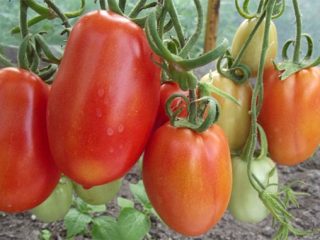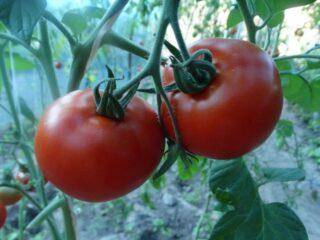Content
The Amur Tiger tomato is a high-yielding, mid-early, indeterminate variety. Thanks to its unusual coloring, it attracts interest from experienced and novice gardeners. Suitable for growing in greenhouses and outdoors. The main thing is that the soil is not oversaturated with organic fertilizers. On such soil, the fruits do not set well; all the strength of the plant goes into the growth of leaves and shoots.
History of selection
The development of the bicolor, which in some sources is called the Siberian tiger, was carried out by breeders of the Aelita agricultural company. The variety was obtained in 2014. The Amur tiger was included in the State Register of Russia a year later, having passed testing in risky farming zones.
Description of the tomato variety Amur Tiger
The Amur Tiger is a productive, mid-season, indeterminate variety. The bush is powerful, reaches 1.5-2 m in height. The stem is thick, strong, requires gartering to a support, and needs pinching. The leaves are medium sized, regular in shape. The root system is well developed.The peduncles are large, 5-10 ovaries are formed in each fruit cluster.
The tomatoes are large, weighing up to 200 g; there are specimens up to 400 g. The fruits are round in shape, slightly flattened. Exotic bicolor differs from others by dark green stripes on the peel. They stand out on both unripe and ripe tomatoes. Stripes on the peel remain even after heat treatment.
The pulp of ripe fruits is tender, juicy, and sweet. The taste qualities were highly appreciated by gardeners. At the same time, they note that in sunny areas the sugar content of berries is higher than that of fruits ripened in the shade.
Characteristics of the Amur Tiger tomato
From sowing to harvesting the first ripe fruits, 110-115 days pass. Bicolor normally tolerates short-term drops in temperature, but in hot weather it can shed some of its flowers, which significantly reduces yield.
Tomato yield Amur Tiger
Subject to agrotechnical cultivation standards, 3-5 kg are harvested from one bush.

Amur Tiger tomatoes, cultivated under film, yield 11-11.5 kg per 1 m2
Resistance to diseases and pests
The culture has good immunity and does not suffer from tobacco mosaic virus and Alternaria blight. In cold, damp summers, tomatoes are susceptible to late blight.
Application area
When fresh, the harvest does not last long, but fruits picked in the milky ripeness stage tolerate transportation well.
Reviews from those who have grown Amur Tiger pink tomatoes indicate that due to the too thin skin, this variety is not suitable for whole-fruit canning. During heat treatment, the skin bursts. It is recommended to harvest the fruits using the barrel method.

Bicolor Amur Tiger is suitable for fresh consumption, preparation of tomato juice, sauces, ketchups
Advantages and disadvantages of the Amur Tiger tomato
Tomatoes can be cultivated both in open ground and in a greenhouse. The originators claim that the variety is immune to a number of diseases that affect other crops of the nightshade family.

The Amur tiger can be bred with independently collected seeds
Pros:
- versatility of use (for preparing salads, sauces, tomato juice);
- the fruits do not fall from the bush even after overripe;
- high yield of the variety;
- good taste;
- unusual appearance of berries.
Minuses:
- in regions with difficult climatic conditions, the variety must be cultivated under a film cover, since without it the tomatoes do not have time to ripen;
- due to its thin skin, it is not suitable for whole-fruit canning;
- ripe fruits do not tolerate transportation well. To preserve the presentation of Amur Tiger tomatoes, they must be collected in the milky ripeness phase;
- pinching should be carried out in a timely manner, in 1-2 shoots;
- It is not only the stem of the plant that needs tying; it is recommended to fix it to the support and the bunch;
- Tall bushes should be pinched a month before harvest.
Features of planting and care

Amur Tiger tomatoes are grown in seedlings
Sowing is carried out in the period from the second ten days of March to April 10 (in regions with different climatic conditions, the timing may differ. Sowing is carried out 55-60 days before planting in the ground. At the stage of 2-3 leaves, seedlings are planted at a distance of 7-10 cm from each other. Daylight hours should be at least 15 hours. Plants should be hardened off before planting.
When the soil warms up to a temperature of +15 ᵒC, the seedlings are transplanted to a permanent place. Tomatoes are planted under film cover after May 15, on the plot - in early June. You should choose a sunny, but sheltered place from direct sunlight. Onions, cucumbers and carrots are considered good predecessors. It is not recommended to grow tomatoes after peppers, eggplants and potatoes.
At 1 m2 no more than four plants are planted. The procedure is recommended to be carried out in cloudy weather. Bushes of this variety need staking. On the northern side of the bush, at a distance of 10 cm from the plant, install pegs with a height of at least 70-80 cm. The tomatoes are tied after the fifth true leaf appears.
It is recommended to carry out pinching every week so that the plant’s nutrients are not wasted. In greenhouse conditions, the bush is formed into one stem, in open ground - into 1-2. Stepsons do not pull them out, but break them out. If the shoots have grown too large, they are carefully cut out with a sharp knife or pruning shears.
In hot weather, watering is carried out twice a week. The best way is drip irrigation. The water must be settled, make sure that it does not fall on the leaves. It is better to water in the morning or evening. After each irrigation, it is recommended to loosen the soil to saturate the roots with oxygen. In addition, it is necessary to weed and remove weeds every 10 days.
Light-colored mulch reflects sunlight well; tomatoes receive more sun. In this case, the yield increases by 25%, and the ripening of the first fruits occurs a week earlier.
It is recommended to fertilize with herbal infusions, ash and mineral fertilizers. A large amount of organic matter contributes to the growth of the deciduous mass of the bush and the appearance of stepsons. We should not forget about magnesium and calcium; their deficiency will lead to a decrease in yield. At least 12-14 days should pass between soil fertilization procedures.
Pest and disease control
For preventive purposes, in order to avoid late blight damage to tomatoes, it is recommended to remove foliage from the lower part of the stem (approximately up to 1/3 of the shoot). This will ensure good ventilation. Before ripening begins, it is necessary to treat the beds with chemical preparations “Thanos” and “Ridomil Gold”, using them strictly in accordance with the instructions.
Among the pests, the Amur Tiger variety is especially popular with aphids and whiteflies.

When the first signs of parasite damage are detected, the seedlings should be treated with Confidor solution
Conclusion
The Amur Tiger tomato has been cultivated by Russian gardeners relatively recently. There is no clear picture characterizing the variety yet, but it is already clear that the mid-early tomato has more advantages than disadvantages. The Amur tiger attracts attention with its unusual coloring, large fruits and high resistance to diseases.
Reviews from gardeners about the Amur Tiger tomato








